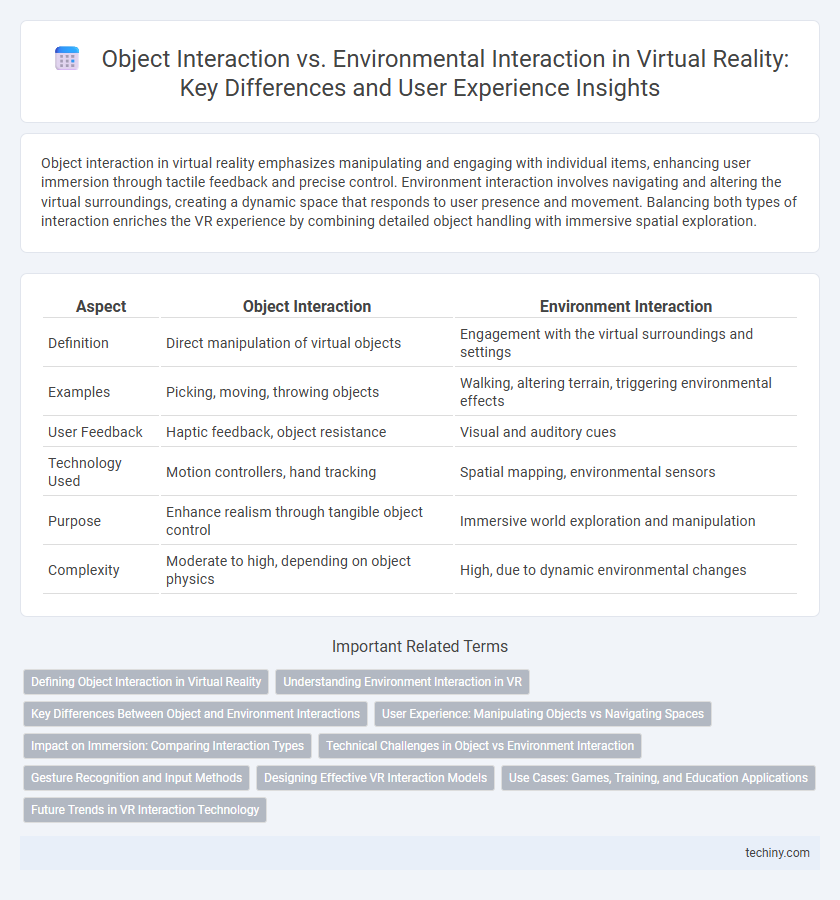Object interaction in virtual reality emphasizes manipulating and engaging with individual items, enhancing user immersion through tactile feedback and precise control. Environment interaction involves navigating and altering the virtual surroundings, creating a dynamic space that responds to user presence and movement. Balancing both types of interaction enriches the VR experience by combining detailed object handling with immersive spatial exploration.
Table of Comparison
| Aspect | Object Interaction | Environment Interaction |
|---|---|---|
| Definition | Direct manipulation of virtual objects | Engagement with the virtual surroundings and settings |
| Examples | Picking, moving, throwing objects | Walking, altering terrain, triggering environmental effects |
| User Feedback | Haptic feedback, object resistance | Visual and auditory cues |
| Technology Used | Motion controllers, hand tracking | Spatial mapping, environmental sensors |
| Purpose | Enhance realism through tangible object control | Immersive world exploration and manipulation |
| Complexity | Moderate to high, depending on object physics | High, due to dynamic environmental changes |
Defining Object Interaction in Virtual Reality
Object interaction in virtual reality refers to the ability of users to engage directly with virtual items through actions such as grabbing, manipulating, and examining objects within a digital space. This interaction is enabled by advanced tracking technologies and haptic feedback systems that simulate tactile sensations, enhancing immersion and realism. Defining object interaction highlights its role in creating intuitive interfaces and fostering meaningful user engagement in VR environments.
Understanding Environment Interaction in VR
Environment interaction in virtual reality refers to the user's ability to engage with the virtual world beyond individual objects, including manipulating terrain, navigating spaces, and experiencing dynamic changes in the environment. This interaction enhances immersion by allowing users to affect environmental conditions such as lighting, weather, or soundscapes, creating a more realistic and responsive VR experience. Understanding environment interaction requires integrating spatial mapping, physics engines, and user input to simulate natural responses within the virtual world.
Key Differences Between Object and Environment Interactions
Object interaction in virtual reality involves direct manipulation of virtual items, such as picking up, moving, or using tools, emphasizing precision and tactile feedback. Environment interaction focuses on navigating and altering the virtual space itself, such as opening doors, changing lighting, or modifying terrain, highlighting broader situational engagement. Key differences lie in the scale of interaction--object interactions target individual elements, whereas environment interactions address spatial and contextual changes affecting the user's immersive experience.
User Experience: Manipulating Objects vs Navigating Spaces
Manipulating objects in virtual reality demands precise hand-tracking and intuitive controls to replicate real-world tactile feedback, enhancing user immersion. Navigating virtual environments relies on fluid locomotion systems and spatial orientation cues that prevent motion sickness and maintain comfort. Balancing these interactions optimizes user experience by delivering natural object handling alongside seamless exploration of expansive VR spaces.
Impact on Immersion: Comparing Interaction Types
Object interaction in virtual reality enhances immersion by allowing users to manipulate and engage with specific items, creating a tangible sense of presence. Environment interaction broadens this experience by enabling users to navigate, modify, or respond to the surrounding virtual space, fostering a more dynamic and holistic engagement. Together, these interaction types synergistically deepen user immersion, leveraging tactile feedback and spatial awareness to produce a compelling virtual experience.
Technical Challenges in Object vs Environment Interaction
Technical challenges in virtual reality object interaction center on precise collision detection, realistic haptic feedback, and accurate physics simulation to ensure convincing grasping and manipulation of virtual items. Environment interaction demands robust spatial mapping, scalable rendering of expansive virtual worlds, and adaptive environmental responsiveness to user actions, which requires advanced sensor integration and real-time data processing. Balancing computational load between detailed object physics and dynamic environment changes remains a critical hurdle for immersive VR experiences.
Gesture Recognition and Input Methods
Gesture recognition in virtual reality enhances object interaction by enabling intuitive hand movements to manipulate and control virtual items with precision. Environment interaction relies on diverse input methods such as motion controllers, haptic gloves, and eye tracking to navigate and modify virtual spaces dynamically. Optimizing these modalities improves immersion and responsiveness, bridging the gap between user intent and virtual feedback.
Designing Effective VR Interaction Models
Designing effective VR interaction models requires a clear distinction between object interaction and environment interaction to enhance user immersion and usability. Object interaction focuses on manipulating specific items, emphasizing precision, feedback, and natural gestures, while environment interaction involves navigating and altering the broader virtual space through locomotion, spatial awareness, and context-sensitive controls. Balancing these elements with intuitive design principles and haptic feedback improves engagement and reduces cognitive load in virtual reality experiences.
Use Cases: Games, Training, and Education Applications
Object interaction in virtual reality enhances immersive experiences in games by enabling precise manipulation of items, promoting skill development in training simulations through realistic tool handling, and supporting hands-on learning in educational applications with interactive 3D models. Environment interaction allows users to navigate and alter virtual surroundings, critical for exploration-based games, situational awareness in training scenarios such as emergency response drills, and contextual learning in education by simulating real-world environments. Combining both interaction types maximizes user engagement and effectiveness across diverse VR use cases.
Future Trends in VR Interaction Technology
Future trends in VR interaction technology emphasize seamless integration of object interaction and environment interaction through advanced haptic feedback systems and AI-driven gesture recognition. Enhanced spatial awareness and adaptive response mechanisms will enable more immersive and intuitive manipulation of virtual objects within dynamic environments. These innovations predict a shift towards embodied interaction models, fostering deeper user engagement and more realistic virtual experiences.
Object Interaction vs Environment Interaction Infographic

 techiny.com
techiny.com